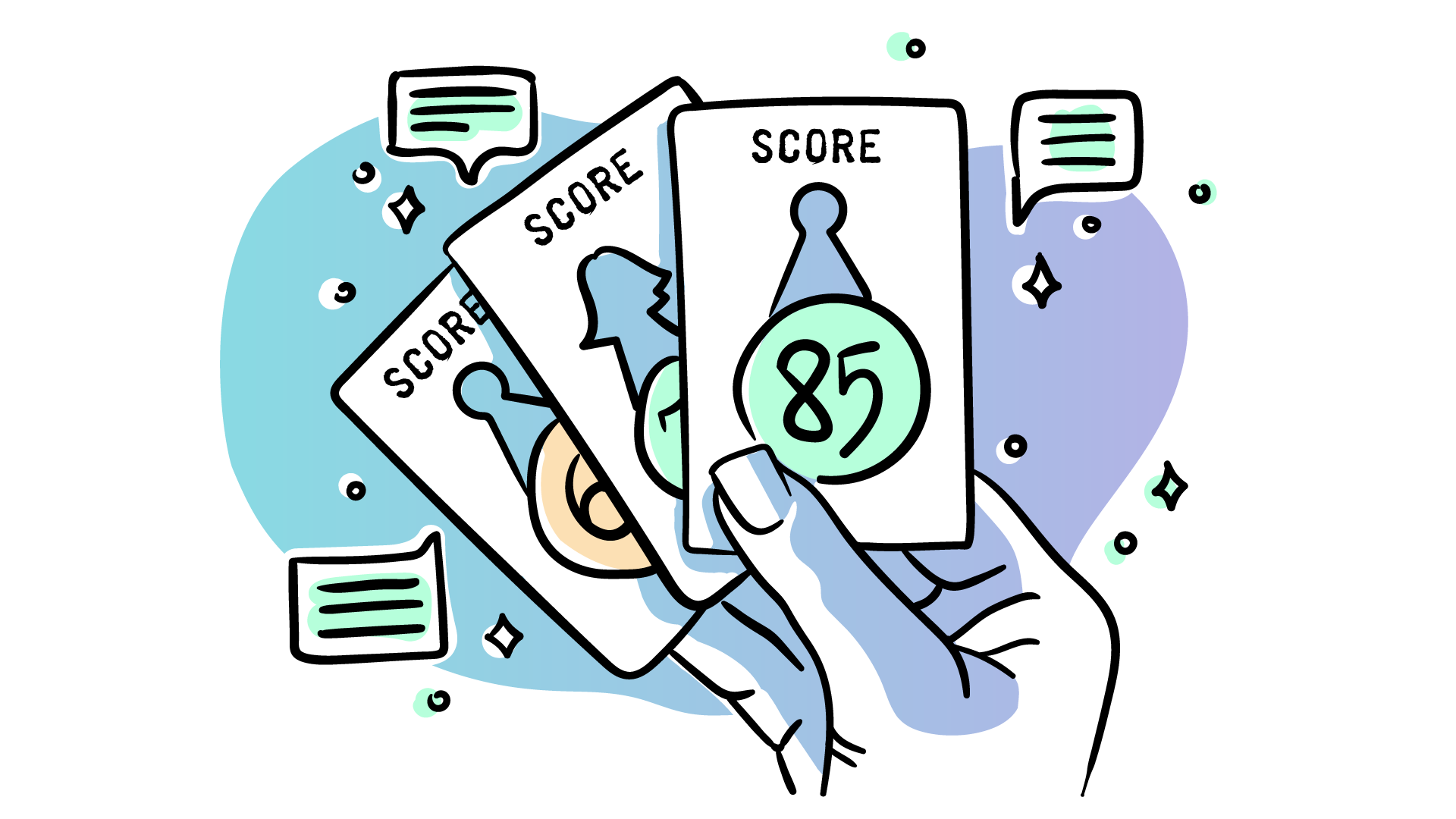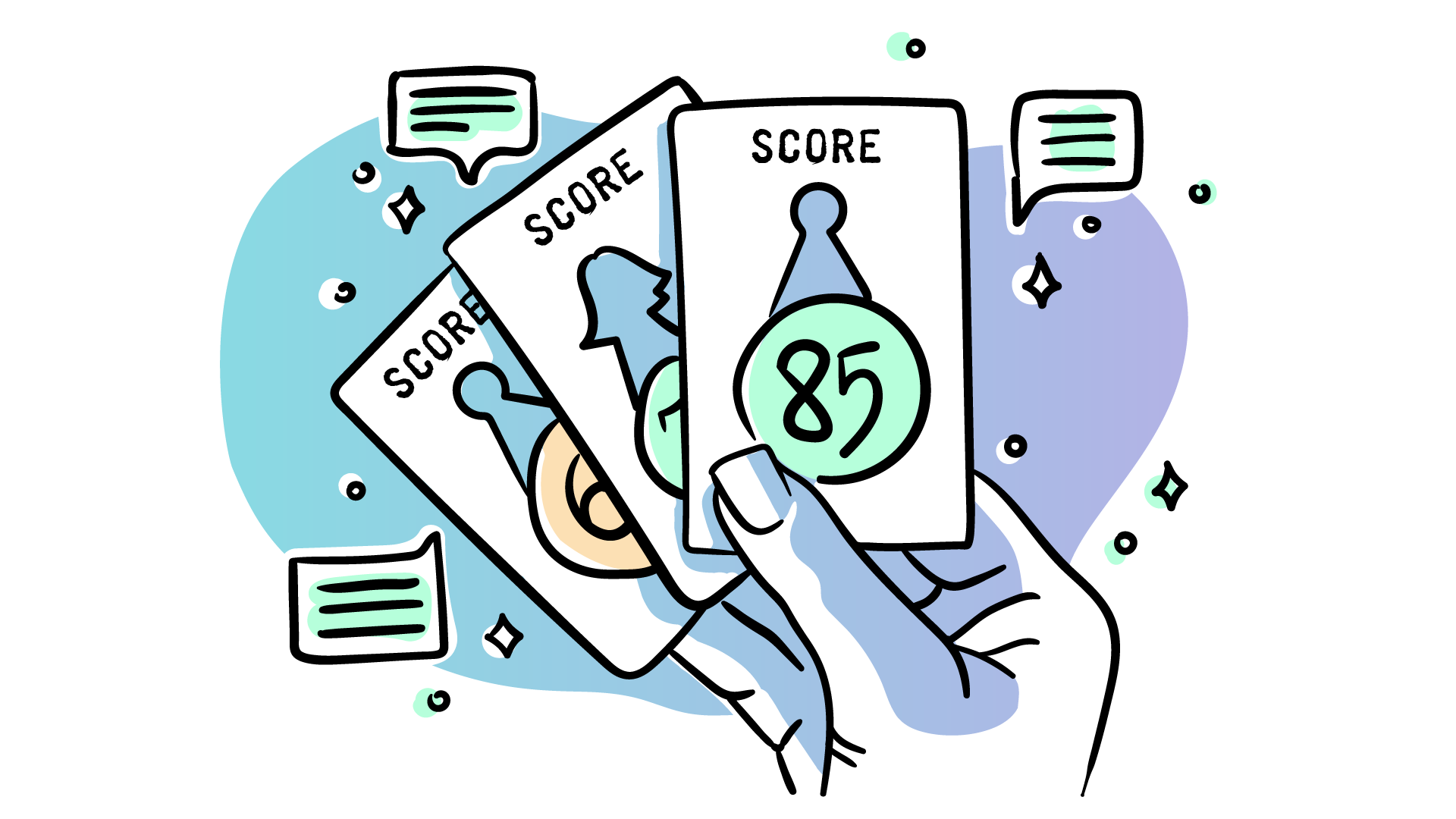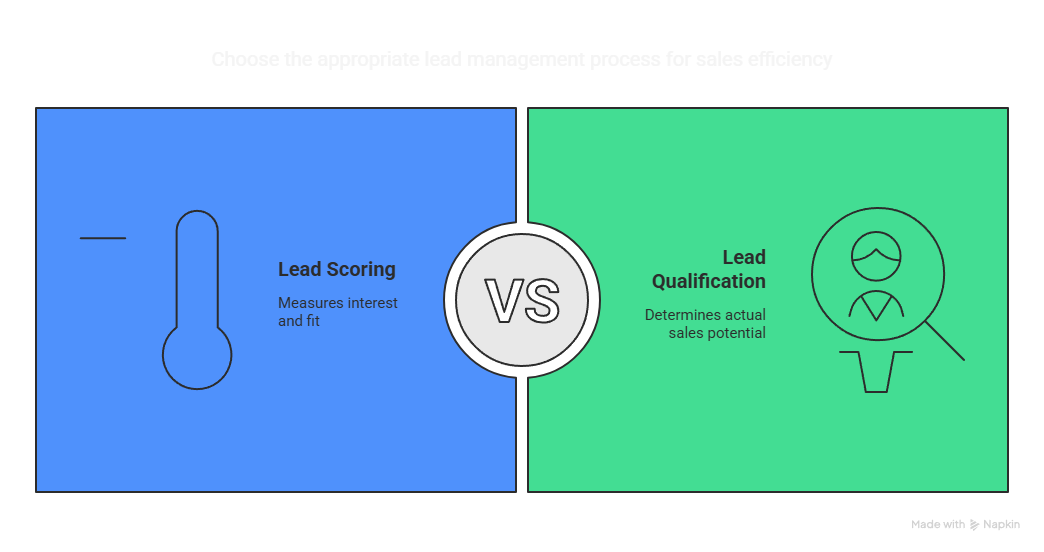Lead Scoring: How to Find Your Hottest Prospects

Finding great prospects can feel like searching for a needle in a haystack—or, if you're really unlucky, finding your keys after a wild night out. But what if there was a way to instantly know who's ready to buy and who’s just casually browsing? Welcome to lead scoring, the ultimate lifesaver for your sales team.
This simple yet powerful method helps you prioritize your hottest leads, save valuable time, and boost your sales without losing your sanity. Let's dive in and make lead scoring your new best friend!
What is Lead Scoring?
Lead scoring is the process of assigning numerical values (points) to leads based on how likely they are to become paying customers. These scores are calculated using a mix of:
- Demographics (job title, company size, location)
- Firmographics (industry, revenue, market segment)
- Behavioral data (email opens, form submissions, site visits)
- Engagement history (downloads, webinar attendance, demo requests)
The higher the score, the more qualified and sales-ready the lead. It’s like giving your sales team a heat map of who’s most likely to convert—so they can spend less time guessing and more time closing.
Why Lead Scoring is Crucial for Maximizing Sales and ROI

Lead scoring matters because it streamlines your sales process, boosts productivity, and helps you focus on what really counts: the right leads.
Here’s how it brings serious value to your business:
- Improves Sales and Marketing Alignment: Sales and marketing can finally agree on what makes a “good lead.” When both teams work from the same scoring model, there’s less finger-pointing and more deal-closing.
- Increases Conversion Rates: By identifying your hottest leads, your sales team can prioritize outreach and personalize their pitch—resulting in better conversations and more conversions.
- Shortens the Sales Cycle: Why waste time on cold leads when the warm ones are waving at you? Lead scoring helps you strike while the iron’s hot.
- Optimizes Marketing Efforts: Noticing that your highest-scoring leads are coming from a specific campaign or channel? Now you know where to double down. It’s insight-driven marketing at its best.
- Reduces Customer Acquisition Costs: When your team stops chasing the wrong leads, you save time, resources, and budget—leading to a leaner, more efficient acquisition process.
6 Proven Lead Scoring Models for Effective Prospect Evaluation
Chasing every lead? Total time-waster. Some are curious, some are bots, and a rare few are ready to buy. That’s where lead scoring saves the day—by ranking leads so your team can focus on the ones that actually matter.
Here are six proven lead scoring models to help you spot your next big customer faster:
1. Company Profile Lead Scoring

Because selling to a Fortune 500 company isn’t the same as selling to your cousin’s Etsy side hustle.
This model evaluates leads based on details about the company they work for. Is it a startup or an established enterprise? What industry are they in? How many employees? What’s their estimated revenue?
These factors matter because they influence the lead’s buying power and potential deal size. For instance, if your product is tailored for large-scale operations, then a company with 1,000+ employees should automatically score higher than a team of three in a co-working space.
Key attributes to score:
- Company size (employee count)
- Industry type (B2B, SaaS, eCommerce, etc.)
- Annual revenue
- Geographic location
- Growth indicators (recent funding, expansion news)
2. Demographic-Based Lead Scoring
Because targeting the wrong person is like pitching steak to a vegetarian.
Demographic scoring looks at who the individual lead is. You could be talking to someone at Google, but if they’re an intern in the cafeteria and you’re selling enterprise software, they’re not your ideal customer.
Instead, score leads higher if they match your ideal buyer persona. Are they a decision-maker? Do they work in the right department? Is their job title aligned with the kind of user or buyer you’re looking for?
Demographic data to evaluate:
- Job title or seniority level
- Department (e.g., Marketing, IT, Procurement)
- Age or experience level (if relevant)
- Education or certifications (for niche products)
- Location (especially for territory-based sales teams)
3. Lead Behavior and Online Activity Scoring

Because if they’re binge-watching your blog, they’re probably into you.
This model tracks how leads interact with your website and content. Are they visiting your product pages, downloading whitepapers, or signing up for webinars? Each of these actions signals interest—and the more meaningful the action, the higher the score.
For example, reading a blog post might be worth 5 points, but requesting a demo? That’s a 25-pointer right there.
Behavioral indicators to watch:
- Number of website visits and frequency
- Pages visited (especially pricing or feature pages)
- Time spent on site
- Resource downloads (eBooks, case studies)
- Webinar or event attendance
- Form submissions and inquiries
4. Email Engagement for Lead Scoring
Because if they open your emails like it’s Black Friday, it’s game on.
Email activity is a classic signal of interest. If a lead is opening your emails, clicking links, and forwarding content to coworkers, they’re actively engaging with your brand—and that’s worth scoring.
But if your emails are getting ghosted harder than a bad Tinder date? Time to lower that score and focus elsewhere.
Email engagement factors to score:
- Open rates
- Click-through rates (CTR)
- Link click depth (how many and which links they click)
- Reply rate
- Email forwards or shares
5. Social Media Interaction and Engagement Scoring

Because likes = love (sort of).
Social media can be a goldmine for lead intent. If a lead is liking your posts, sharing your thought leadership, or sliding into your DMs, that’s a clear sign they’re engaged with your brand.
While it may not carry as much weight as a demo request, social engagement still offers a valuable peek into brand affinity and can help you identify warm leads early.
Social signals worth scoring:
- Likes and reactions on your content
- Comments (especially insightful or specific ones)
- Shares or retweets
- Tagging others in your posts
- Following or connecting with your brand on platforms like LinkedIn
6. Spam Detection to Ensure Accurate Lead Scoring
Because nobody wants to pitch to “Joe Test” from “[email protected].”
Not all leads are legit. Some are fake, some are bots, and some are just people filling out your form so they can access a free download with no intention of buying.
A good lead scoring system includes spam filters to weed out the nonsense before your sales team wastes valuable time. It also ensures your lead scoring remains accurate and doesn’t inflate your pipeline with junk.
Red flags for spam leads:
- Generic or obviously fake names (“asdf asdf” or “Mickey Mouse”)
- Suspicious email domains (e.g., @mailinator.com, @test.com)
- Nonsensical company names or job titles
- Duplicate entries or identical behavior across multiple leads
- No engagement beyond the initial form fill
How to Build a Killer Lead Scoring System in 4 Simple Steps

Because guessing who’s ready to buy is sooo 2010.
A good lead scoring system is like having x-ray vision for your sales funnel—it helps you see which leads are hot, which are not, and where to focus your time. But slapping random numbers on email clicks won’t cut it. You need a strategic, flexible system that actually reflects your buyer’s journey.
Whether you're starting from scratch or revamping a clunky old model, here’s how to build a lead scoring system that actually works—in just four straightforward steps.
Step 1: Clearly Identify Your Target Audience
If you don’t know who you're selling to, you’re basically throwing darts in the dark.
Before you assign scores to anything, you need to know who matters most to your business. Start by narrowing in on your ideal market segment. Who are the people or companies that get the most value from your product or service?
Ask yourself:
- What industries do they belong to?
- What’s their company size or budget range?
- What are their common pain points?
- Are you selling to startups, enterprise, nonprofits, or niche sectors?
Getting clear on your target audience ensures your lead scoring system is aligned with the people who are most likely to convert—so you don’t waste time chasing the wrong ones.
Step 2: Define and Understand Your Ideal Customer
You can’t build a dream client list if you don’t know what the dream looks like.
Once you’ve got your broader audience defined, zoom in and create a detailed Ideal Customer Profile (ICP) or buyer persona. This includes specific characteristics about the individuals or teams you want to sell to.
Here’s what to define:
- Job title & department: Are they decision-makers or influencers?
- Seniority level: A junior assistant might love your product, but can they buy it?
- Pain points: What problems are they trying to solve?
- Behavior patterns: How do they typically interact with brands like yours?
This step turns vague marketing personas into real, actionable scoring criteria. It’s the difference between “we sell to tech companies” and “we sell to CTOs at mid-size SaaS companies struggling with data integration.”
Step 3: Assign Points to Valuable Lead Actions
Not all clicks are created equal.
This is where the magic happens: assigning scores to behaviors and attributes that show genuine buying intent. Think of it like a game—each action earns points based on how close it brings a lead to becoming a customer.
Examples of point values:
- +1 for opening an email
- +3 for clicking a CTA
- +5 for downloading a whitepaper or guide
- +10 for attending a webinar or requesting a demo
- +15 for visiting your pricing page multiple times
Also, don't forget negative scoring. Subtract points for things like:
- Using a personal email address instead of a business one
- Inactivity over a certain period
- Job titles or industries outside your target zone
This step helps you separate the curious browsers from the serious buyers.
Step 4: Regularly Analyze and Adjust Your Scoring Model

Set it and forget it? Nope. Lead scoring is a living, breathing system.
Your market changes, your sales cycle evolves, and your customers shift. That’s why your lead scoring model should never be static. The goal is to fine-tune regularly to ensure accuracy and performance.
How to stay sharp:
- Review high-scoring leads that didn’t convert—what went wrong?
- Monitor conversion rates from MQL (marketing qualified lead) to SQL (sales qualified lead).
- Ask sales for feedback: Are they spending time on the right leads?
- Use A/B testing to tweak score weights and thresholds.
When done right, regular analysis makes your scoring smarter over time—so your team is always chasing the leads that actually matter.
How to Calculate Your Lead Score: 3 Methods Explained
Not all businesses need a data science team to score leads—but knowing your options helps you pick the right approach for your size and goals.
- Logistic Regression Lead Scoring Method
Fancy name, simple concept. Uses math (ugh, we know) to predict lead conversions based on historical data. Great for bigger businesses with loads of leads.
- Predictive Lead Scoring with Machine Learning
Like logistic regression but smarter, thanks to machine learning. It considers past behavior to predict future success. If Skynet were in sales, this would be it.
- Manual Lead Scoring for Small Businesses
For smaller businesses, good old-fashioned manual scoring can work wonders. It's custom, easy to adjust, and doesn’t require a Ph.D. in stats.
Should You Use Multiple Lead Scores for Better Results?
Short answer: Probably. Different scores for different segments (like geography or industry) make your targeting laser-focused. This helps avoid mixing your B2B leads with B2C prospects—like putting pineapple on pizza. It just doesn’t work.
7 Essential Tips for Effective Lead Scoring Management

Because “winging it” doesn’t close deals.
Lead scoring can be a game-changer for sales and marketing alignment—but only if it's done right. A messy, unclear, or outdated system can cause more confusion than clarity. The key? Proper lead scoring management. Once your model is set up, managing it effectively ensures you're always targeting the right people, at the right time, with the right message.
Here are seven essential tips to keep your lead scoring machine running like a dream:
1. Understand Explicit vs. Implicit Lead Scores
One tells you who they are. The other tells you what they’re up to.
Start by differentiating between the two types of scoring criteria:
- Explicit scores are based on factual, provided data—like job title, company size, industry, and location. These tell you who the lead is.
- Implicit scores track behavior—like website visits, content downloads, or email engagement. These reveal how interested they are.
Effective lead scoring systems balance both. For example, a CEO (explicit) who downloaded your pricing guide and attended your webinar (implicit)? That’s someone to call yesterday.
2. Set Clear Lead Scoring Thresholds
If your sales team has to guess who’s ready to talk, your scoring isn’t doing its job.
Determine and communicate what score qualifies a lead to move from MQL (marketing qualified lead) to SQL (sales qualified lead). Set specific thresholds so there’s no confusion between “just browsing” and “take my money.”
Examples:
- 0–30 points: Cold
- 31–60 points: Warm
- 61+ points: Hot / Ready for sales follow-up
Adjust these ranges over time based on real conversion data.
3. Align Your Sales and Marketing Teams

Sales and marketing should be partners in crime—not pointing fingers.
Marketing generates leads. Sales converts them. So why are these two teams often disconnected? Make sure they’re working from the same definition of what a qualified lead looks like.
Hold regular meetings to:
- Share lead feedback
- Review scoring criteria
- Discuss performance and lead quality
When both teams agree on what matters, the whole funnel flows more smoothly—and close rates go up.
4. Reward Positive Customer Actions

If someone’s engaging with you, make it count.
Positive behaviors should always be recognized with point increases. Visiting your site five times in a week? +5. Downloading an eBook and signing up for your newsletter? +10. Asking to schedule a demo? Go ahead and throw a party.
These actions signal intent—and intent is the golden ticket. Make sure your scoring model reflects that.
Bonus tip: Not all actions are equal. Assign more weight to high-intent actions like demo requests or pricing page visits than casual behaviors like blog reading.
5. Stick Closely to Your Buyer Personas
Just because someone’s interested doesn’t mean they’re the right fit.
No matter how many times someone opens your emails, if they’re nowhere near your target persona, they probably won’t convert. Your lead scoring model should prioritize quality over quantity.
Keep a checklist of must-have persona traits:
- Job title or role
- Industry and company size
- Budget range
- Location or territory
Leads that match these traits should always earn higher scores—while out-of-profile leads should be downgraded or even disqualified automatically.
6. Regularly Monitor and Update Lead Scores
Lead scoring is not a "set it and forget it" situation.
Your ideal customer profile may change. Buyer behavior evolves. What worked last quarter may flop this quarter.
Review your lead scoring system regularly to:
- Reassess point values
- Add or remove scoring rules
- Identify patterns in non-converting leads
Also, listen to your sales team. If they’re getting a bunch of “high-scoring” leads that don’t convert, that’s a clear sign your model needs a tune-up.
7. Leverage the Best Lead Scoring Tools Available

Doing this manually? You’re working too hard.
Lead scoring can get complex fast, especially as your funnel grows. That’s why automation is your best friend. Tools like HubSpot, Marketo, Salesforce, or Leadplay.io take the heavy lifting out of the process.
Look for features like:
- Behavior tracking across channels
- Custom scoring rules
- CRM integration
- Real-time updates and alerts
- Easy reporting and analytics
A good tool not only automates scoring but gives you visibility into what’s working—and what’s not.
Lead Scoring vs. Lead Qualification: What’s the Difference?

One warms up the plate, the other serves the steak.
At first glance, lead scoring and lead qualification might sound like two names for the same thing—but they’re actually two distinct steps in a winning sales process. Understanding the difference (and how they work together) can help you build a funnel that’s both efficient and high-converting.
Lead Scoring: The Appetizer
Lead scoring is all about measuring interest and fit. It’s a points-based system that automatically ranks leads based on factors like:
- Who they are (job title, company size, industry, etc.)
- What they do (downloads, email opens, website visits)
- How closely they match your buyer persona
This gives your marketing and sales teams a quick, data-driven snapshot of which leads are engaged and potentially worth pursuing. Think of it as a first filter—it tells you who’s warming up and getting hungry.
But here’s the catch: just because someone looks good on paper and interacts with your emails doesn’t mean they’re ready to buy.
That’s where lead qualification steps in.
Lead Qualification: The Main Course
Lead qualification digs deeper to find out if a lead is actually worth your sales team’s time. It goes beyond engagement metrics to answer key questions like:
- Do they have a budget?
- Are they the decision-maker?
- What’s their timeline to buy?
- Is there a real need your product can solve?
This usually happens through a discovery call, form responses, or a deeper CRM analysis. Frameworks like BANT (Budget, Authority, Need, Timing) or CHAMP (Challenges, Authority, Money, Prioritization) are often used here.
In other words, qualification is where you separate the curious from the committed.
Why You Need Both
Lead scoring prioritizes leads so your team focuses on the most promising ones first. Lead qualification confirms whether those promising leads are sales-ready. Together, they create a smooth pipeline that moves the right prospects closer to conversion—without wasting your team’s time.
So while scoring is the appetizer that whets your appetite, qualification is the entrée that gives you the substance. Ignore either, and your sales process might leave you... well, a little hungry.
Wrapping It Up: Make Lead Scoring Work for You
Lead scoring isn't rocket science—it's about knowing who's ready to buy and who needs a nudge. Follow these tips, use the right tools, and watch your conversion rates climb faster than your coffee intake on a Monday morning. Happy scoring!